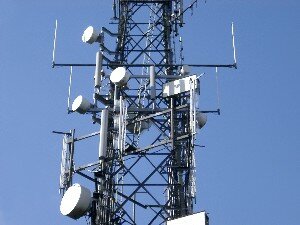NEWS- Freeze frame: Is anyone still watching broadcast?
If ABC suddenly froze in the middle of a new episode of Desperate Housewives, hordes of angry viewers would probably descend upon the network headquarters. However, when an award-winning PBS affiliate broadcast a frozen frame for two or three days in Central Virginia, response was far less dramatic– which raises the question: is anyone really watching broadcast television anymore?
When PBS viewer Kevin Cox turned on WVPT at broadcast channel 50 on Saturday morning, June 17, he was surprised to see a frozen image of what appeared to be a man holding a saw. "I think it means no one was paying any attention: the viewers weren't watching, and the station wasn't watching," Cox says.
Although WVPT beams a signal from a mountain towering over Charlottesville, many area viewers get their PBS programming through a cable or satellite provider– or from WVPT's PBS competitor, WHTJ. When Channel 50's transmitter went down that Saturday, only PBS viewers without such options were affected.
"It doesn't speak poorly of their overall viewing audience," says local blogger Waldo Jaquith. "It just shows that we've all moved away from broadcast TV."
Cox says he periodically monitored the screen that weekend and found the frame continually frozen on channel 50. It wasn't until around 3pm Monday, June 19, that the technical glitch was cured and the image unstuck.
"I thought it was humorous," Cox says. "That a TV station could possibly broadcast an image for three days without knowing blew me away."
Though the duration of WVPT's technical difficulty raised some eyebrows, such an outage is not unprecedented in public broadcasting, according to Jaquith.
But Cox was amazed– and his amazement grew when he and his wife received an email from the station's general manager at 8:54pm the night the problem was solved.
"I've passed your question on to my tech people," Schmidt wrote in response to a message from Cox, "who should get back to you soon. Assuming you mean Channel 51, you're the first to have mentioned it to us."
"It seemed from the email that the station manager didn't even know they had a channel 50," Cox says.
However, according to Bert Schmidt, WVPT's general manager, his technicians were "all over" the problem that weekend. Schmidt, who'd been out of town, says he was the only one caught unaware.
"The technical difficulty interrupted our 'Saturday Night Sillies,' which are some of our highest-rated programming," Schmidt says. "A lot of people called, emailed, and wrote."
Jaquith offers another view of WVPT's response.
"When I have websites down, I will often email everybody and thank them for bringing it to my attention," he says. "It doesn't mean they brought it to my attention. I want them to feel valued and to alert me to problems in the future."
WVPT's PBS programming runs through multiple transmitters, with its main signal emanating over channel 51 from one located in Augusta County. The Charlottesville signal, channel 50, comes from equipment on Carter Mountain, the site to which the technically difficulty was confined, Schmidt says.
In an telephone interview, Schmidt says the station was fully aware of what he terms a 48-hour freeze and says a difficult diagnosis, not anyone's negligence, was to blame for the duration of the outage. Schmidt says that during the freeze his staff was busy working at the station, speaking to vendors, and working at the malfunctioning translator site.
"It's like if your personal computer froze, and you had to have someone come in and fix the problem for you," Schmidt explains. "In the digital world of television, computers lock up and freeze. We couldn't fix the problem as soon as we would have liked," Schmidt said.
Cox, however, remains skeptical.
"I just question how the TV station could broadcast the frozen image for three days," he says. "I really wonder if they're that unaware."
WVPT's Schmidt regrets the delayed nature of the cure, and attributes part of the problem to tight funding that prevents the non-profit station from maintaining a human presence at the Carter Mountain transmitter.
"Having people at all our transmission sites gets too expensive," he says. "If we had people located there, the problem response might have been better. Severe cuts in funding ultimately affect the viewer."
Although he has limited experience working with television, Jaquith has worked for publicly supported radio station WTJU. "The sorts of systems that don't tend to break are expensive," Jaquith says.
Nonetheless, WVPT is taking an active stand to combat future calamities by improving equipment and technical processes, Schmidt says. "We have operators in here over the weekend, and they'll be checking the transmitter to make sure it's working. They will call the engineer who will be able to fix technical problems when something like that happens."
And even Cox intends to stick with WVPT– to a point. "I'll keep watching," he says, "if they have things on there worth watching."


Is anybody out there?
#